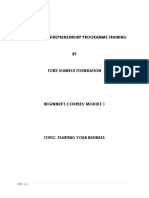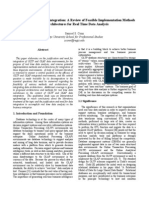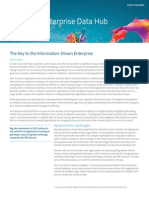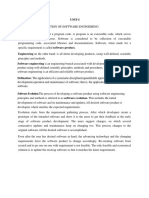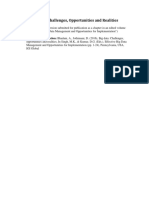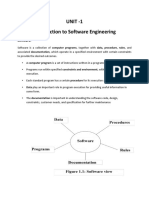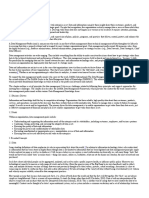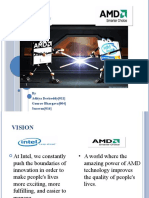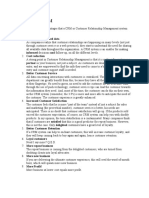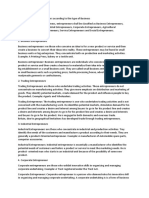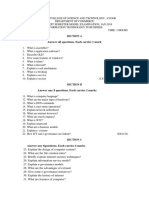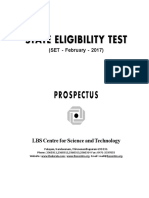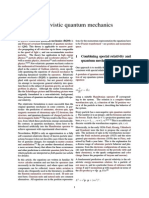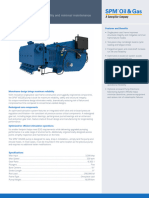Professional Documents
Culture Documents
Customer Relationship Management
Customer Relationship Management
Uploaded by
Naveen Jacob JohnOriginal Description:
Original Title
Copyright
Available Formats
Share this document
Did you find this document useful?
Is this content inappropriate?
Report this DocumentCopyright:
Available Formats
Customer Relationship Management
Customer Relationship Management
Uploaded by
Naveen Jacob JohnCopyright:
Available Formats
Customer Relationship Management
Customer Relationship Management or C.R.M is a
business strategy to select and manage the most valuable
customer relationships. C.R.M requires a customer-centric
business philosophy and culture to support effective marketing,
sales and service processes. C.R.M applications can enable
effective customer relationship management, provided that an
enterprise has the right leadership, strategy and culture.
Customers are treated as the heart of a business and
are considered as its most valuable resource. The ability to
access information about the customers can determine how well
one can understand and use this resource in the business goals
and strategies. Business strategy is about proper application of
information to use the resources in the most efficient and
economical manner. Thus, the process of using and developing
strategies based on customer information is called C.R.M.
In other words, C.R.M is a customer-focused business
strategy designed to optimise revenue, profitability and customer
loyalty. By implementing a C.R.M strategy, an organisation can
improve the business processes and technological solutions
around selling, marketing and servicing functions across all
customer touch points like web, e-mail, phone, fax, and even inperson.
C.R.M covers the methods and the technologies used
by companies to manage their relationship with clients.
Information stored on the existing customers and the potential
customers are analysed and used to this end. Automated C.R.M
processes are often used to generate automatic personalised
marketing based on the customer information stored in the
system.
According to industry view, C.R.M consists of:
a) Helping an enterprise to enable its marketing departments to
identify and target their best customers, manage marketing
campaigns with clear goals and objectives, and generate
quality leads for the sales team
b) Assisting the organisation to improve telesales, account and
sales management by optimising the information shared by
multiple employees and streamlining existing processes. Eg,
taking orders using mobile devices.
c) Allowing the formation of individualised relationships with
customers, with the aim of improving customer satisfaction
and maximising profits; identifying the most profitable
customers and providing them the highest level of service.
d) Providing employees with the information and processes
necessary to know their customers, understand their needs,
and effectively build relationships between the company, its
customer base, and distribution partners.
Uses of C.R.M
In its broadest sense, C.R.M covers all interaction and
business with customers. A good C.R.M programme allows a
business to acquire customers, provide customer services and
retain valued customers. Customer services can be improved by:
1) Providing online access to product information and
technical assistance around the clock.
2) Identifying what the customers value the most and devising
the appropriate service strategies for each customer.
3) Providing mechanisms for managing and scheduling
follow-up sales calls.
4) Tracking all contacts with a customer.
5) Identifying potential problems before they occur.
6) Providing a user-friendly mechanism for registering
customer complaints, handling these problems and
correcting service deficiencies.
7) Storing customer interests in order to target customers
selectively.
8) Providing mechanisms for managing and scheduling
maintenance, repair and on-going support.
Features of C.R.M
C.R.M is a strategy which is customised by an
organisation to manage and administrate its customers and
vendors in an efficient manner for achieving excellence in
business. It has the following features:
1) Customer needs oriented-An organisation can never
assume what a customer actually needs. Without
modulating the actual needs, it is nearly impossible to serve
the customer effectively and also to maintain a long term
deal with them. Hence by using C.R.M, each customer is
properly interviewed about his likes and dislikes so that the
actual needs are ascertained and practised.
2) Proper response to customer queries-Dealing with the
queries and activities of the customer intelligently is very
important for any organisation. This is due to the fact that
misunderstandings could convey undesirable perceptions.
The success of an organisations reactions totally depends
on its understanding and interpretation of the queries and
then to work out the best solution. Through properly
implementing C.R.M, the supplier succeeds in maintaining
a professional and emotional relationship with the customer
by properly answering his queries.
3) Increasing customer satisfaction-Customer satisfaction is
the measure of how the needs and responses are
collaborated and delivered to excel customer expectation.
In todays competitive business marketplace, customer
satisfaction is an important performance exponent and
basic differentiator of business strategies. Hence the more
is customer satisfaction; the more is the business and the
bonding with customers. Thus, C.R.M helps in bridging the
gap between customer expectation and customer
satisfaction.
4) Maintaining customer loyalty-Customer loyalty is the
tendency of the customer to remain in business with a
particular supplier and to buy his products or services
regularly due to being very much satisfied by the supplier.
To continue, maintain and retain the customer loyalty, the
most important aspect to be focused on is the customer
satisfaction. Hence, customer loyalty maintenance is an
influencing aspect of C.R.M and is always crucial for
business success.
5) Retaining customer base-Customer retention is a strategic
process to keep or retain the existing customers and to not
let them diverge or defect to other suppliers or other
business organisations. Usually a loyal customer tends to
stick to a particular brand or product as long as his basic
needs are properly fulfilled and risk seeking a new product.
Thus initiating a proper C.R.M programme helps a business
because the more possibility to retain a customer base, the
probability of net growth of the business.
6) Proper dealing and handling of customer complaintsThere always exists a challenge for the suppliers to deal
with the complaints raised by the customers. A complaint
raised usually indicates that there is dissatisfaction due to a
variety of reasons. These reasons are mostly genuine in
nature but in some cases, it may arise due to some sort of
misunderstanding. The way to handle these complaints is
substantial for any organisation. Hence it is essential for
them to have a predetermined set of processes in C.R.M to
deal and resolve the complaints in no time.
7) Providing efficient customer service-In an organisation,
customer service is the process of delivering information
and services regarding all the products and brands.
Customer satisfaction depends on the quality of service
provided to him by the supplier. If the quality and trend of
service goes beyond the customers expectation, the
organisation is said to have a good business with the
customers. Thus through C.R.M, an organisation has not
only to elaborate and clarify the details of the services to be
provided to the customer but also to abide with the
conditions as well.
Enterprise Resource Planning (E.R.P)
In an organisation, to draw the real benefits from a
technology as powerful as Information Technology (I.T) one has
to devise a system with a holistic view of the enterprise. Such a
system has to work around the core activities of the
organisation, and should provide seamless flow of information
across departmental barriers. Such systems can optimally plan
and manage all the resources of the organisation and hence, they
can be called as Enterprise Resource Planning (E.R.P) systems.
An enterprise is a group of people with a common goal
and which has certain resources at its disposal to achieve that
goal. The group has some key functions to perform in order to
achieve its goal. The resources include money, materials and all
other things that are required to run the enterprise. Planning is
done to ensure that nothing goes wrong. Planning is putting
necessary functions in place and more importantly, putting them
together.
Thus, E.R.P is a method of effective planning of all
resources in an organisation. It covers the techniques and
concepts employed for the integrated management of businesses
as a whole, from the viewpoint of the effective use of
management resources, to improve the efficiency of an
enterprise.
E.R.P packages are integrated (covering all business
functions) software packages that support the E.R.P concepts.
E.R.P software is designed to model and automate many of the
business processes of a company with the intention of
integrating information across the company and eliminating
complex and expensive links between the computer systems.
The success of E.R.P software depends upon reach.
E.R.P systems set of generic processes, produce the dramatic
improvements that they are capable of only, when used to
connect parts of an organisation: and integrate its various
processes seamlessly. The reasons why the market for E.R.P
systems is in great demand are as follows:
a) Improves business performance
b) Reduces cycle time
c) Increases business agility
d) Helps in reducing inventory
e) Helps in improving order fulfilment
f) Supports the requirements of business growth
g) Helps in introducing new products/product lines to attract
new customers
h) Provides flexible, integrated, real time decision support
i) Improves responsiveness across the organisation
j) Takes advantage of untapped mid-market (medium sized
organisations)
k) Increases functionality at a reasonable cost
Advantages of E.R.P
Installing an E.R.P system has many advantages-both
direct and indirect. The indirect benefits include better corporate
image, improved customer goodwill, increased customer
satisfaction. The following are some of the direct benefits of an
E.R.P system:
1) Business integration- The first and most important
advantage lies in the promotion of integration. The reason
why E.R.P packages are considered to be integrated is that
the automatic data updation (automatic data exchange
among applications) is possible among the related business
components. Here, the data of related business functions is
also automatically updated at the time a transaction occurs.
For this reason, one is able to grasp business details in real
time, and carry out various types of management decisions
in a timely manner, based on that information.
2) Flexibility- The second advantage of E.R.P packages is
their flexibility. Different languages, currencies, accounting
standards and so on can be covered in one system, and
functions that comprehensively manage multiple locations
of a company can be packaged and implemented
automatically. To cope with company globalisation and
system unification, this flexibility is essential, and it has
major advantages, not simply for development and
maintenance, but also in terms of management.
3) Better analysis and planning capabilities- Yet another
advantage is the boost to the planning functions. By
enabling the comprehensive and unified management of
related business and its data, it becomes possible to fully
utilise many types of decision support systems and
simulation functions. Furthermore, since it becomes
possible to carry out, flexibly and in real time, the filing
and analysis of data from a variety of dimensions, one is
able to give the decision-makers the information they want
and thus enabling them to make better and informed
decisions.
4) Use of latest technology- The fourth advantage is the
utilisation of the latest developments in Information
Technology (I.T). The E.R.P vendors were very quick to
realise that in order to grow and to sustain that growth, they
had to embrace the latest developments in the field of I.T.
Therefore, they quickly adapted their systems to take
advantage of the latest technologies like open systems,
client/server technology, Internet/Intranet, Computer-aided
Acquisition and Logistics Support (C.A.L.S), electronic
commerce, etc. It is this quick adaptation to the latest
changes in I.T that makes the flexible adjustment to
changes in the future business environments possible and
also makes the incorporation of the latest technology
possible during system customisation, maintenance and
expansion phases.
Other advantages include the following:
5) Improved efficiency
6) Information integration for better decision making
7) Faster response time to customer queries
E.R.P Implementation Strategies
Choosing an E.R.P software implementation strategy
is an important consideration. Before choosing a strategy, it is
important to evaluate each of the options available and
understand each one of them thoroughly. Armed with this
knowledge, there is a high probability of success when it comes
to selecting a strategy that fits the organisations accordingly.
In short, choosing the right implementation strategy is
as important as finding the right programme. A strategy
determines how the E.R.P system is to be installed. On the one
hand, E.R.P software may be installed using very different
processes. On the other hand, one approach or strategy may be
used for different software. The following five strategies form
the basis for all other variants available on the market:
1) Immediate change-over transition (Big Bang)-This
method dominated early E.R.P implementations and is
considered as partially responsible for the massive failure
of these systems. All modules are installed at once across
the entire organisation with all enterprise functions being
transferred concurrently from the legacy system to the new
E.R.P system, either over the course of the weekend or in a
day. The implementation requires careful preparation and
planning to avoid failure and the many resources required
to offer support. This method is rarely used by todays
organisations.
2) Phased transition- This is the most commonly used E.R.P
implementation method where the system modules are
installed per unit and per department. Each business unit
has its own E.R.P instance and database that reduces the
risk of customisation and operation failure due to the
reduced implementation scope of the system. In this
approach, interface programmes are used to bridge the gap
between the legacy system and the new E.R.P programmes
until the entire system is fully functional. This strategy
works where there is no centralised synchronisation in the
project.
3) Parallel transition- This approach keeps both systems
active and in operation for a length of time ranging from
one day to several months, and sometimes for years.
Whether it is the finance, marketing or manufacturing
modules, both E.R.P systems run concurrently allowing in
the fixing of bugs and customisations without affecting
workflow. This approach works where there are mission
critical operations. If a module breaks down, then the other
business processes are not affected.
4) Process line transition- This approach is commonly used
on product lines or product flows and related assets. The
first product line is first transitioned from the legacy system
to the new E.R.P system and its success is monitored. Upon
its successful implementation, the second product line is
similarly moved to the new system and its success is also
measured. This approach is useful when one needs to build
industrial faith on a new system with the goal of increasing
its overall success prospects. Usually, the more complicated
and challenging process lines are transitioned only after
achieving successes with the other lines.
5) Hybrid transition- This is a combination of the above
mentioned implementation strategies. The decision on what
method to use tends to be based on the study of the E.R.P
team members and other necessary information. The size
and type of business also contributes to the simplicity or
complexity of a hybrid strategy. Large conglomerates will
no doubt have complex hybrid systems compared to small
single-site businesses. Hybrids are most preferred where
flexibility in adapting to specific needs is required. They
also allow for exclusive adjustments based in industry
needs.
E.R.P Implementation Lifecycle
The E.R.P implementation project involves different
phases which have definite activities as explained below:
a) Pre-evaluation screening- To search for the perfect
package which will be most suitable in terms of functional
fit of the business process, skill set available and easiness
to adopt.
b) Package evaluation- To understand the performance of the
business and to do the cost benefit analysis.
c) Project planning phase- To make a tentative plan for the
implementation in terms of time, identification of the
person responsible for the coordination of the
implementation programmes, skill development and
monitoring the progress.
d) Gap analysis- To identify the gap between the existing
system and future expectations from the E.R.P system so as
to optimise the outcome from the implementation
programme.
e) Re-engineering- To bring the necessary changes in the
system in terms of physical system, hardware, mindset of
the people, dataflow and reporting.
f) Configuration- To install the necessary hardware, database
management system and configuration of the E.R.P system
accordingly.
g) Testing- To test the system with test data set like entering
data, validating them and generating reports for all modules
and checking their correctness.
h) End user training- To impart training to people from
different functional areas.
i) Going live- To finally switch over to the new system with
data migration and running the system with live data of all
functional areas.
j) Post implementation- To arrange for maintenance of the
system in terms of provision of technical expertise in case
of problems.
Steps in implementation of E.R.P system
The methodology of implementation of the E.R.P
system involves different activities like understanding the need
`
for the system, benefits to be derived, people to be associated,
need for their skill updates, database configuration, etc.
Generally, an E.R.P implementation can be divided into 5
phases:
1) Understanding the problem- This is the phase where indepth analysis of business system is undertaken to
understand the need for an integrated system in handling
data and for improving the data flow towards better
management reporting and effective decision making. The
company goes for the evaluation of different packages and
selects the one which is the perfect fit to the requirement.
The parameters taken into consideration include functional
fit with companys business process, degree of
implementation among various modules, flexibility,
technology requirement, cost of the system, time of
implementation, skill requirement, and technical support
and so on.
2) Defining the solution- This phase considers all the
intricacies of the system so as to take care of all those
during the development process. The gaps in the present
system, scope of improvement in the data flow and need for
integration for better control are the most important three
areas which are critically evaluated to arrive a solution set.
Finally, the outcome of the same is taken into consideration
for the software. This phase gives solution for data
migration process, volume of data and database size, plan
for implementation in terms of technical requirements and
timeframe. In fact in this phase, the project team is built
and project schedule is defined for all broad activities.
3) Undertaking the technical work- In this phase, the
activities are broken into details. The work involved in this
phase include procurement of hardware, configuration of
the system, data migration, developing and testing the
interfaces, developing the new procedure associated with
the system, testing the new system and training the endusers.
4) Going live- In this phase, the system is to be finally
implemented in the new environment with a real life data
set and to the satisfaction of the end-users. In E.R.P
systems, the integration of all the modules is the critical
part. The end-users must understand the sequence of
operations, how one module interacts with the others and
what are the restrictions in operation in terms of priority so
as to establish proper checks at all levels in the process.
The co-ordination among the project members for different
modules is very essential for the smooth and successful
implementation of the E.R.P system.
5) Post-implementation
maintenanceOnce
the
implementation is over, the services of the vendor and the
hired consultants will not be available. Trained in-house
employees may have limited exposure to take care of all the
problems just after implementation. Post implementation
needs a different set of roles and skills to solve the
problems in an integrated system. The training will never
end as new functionality may be added which will invite
different technical problems like enhancement of system,
fresh configuration for added integration features, etc.
Thus, this is a very critical phase. To reap the full benefits
of an E.R.P system, there should be arrangements made for
the continuous training of employees and also for the
system.
Supply Chain Management (S.C.M)
Supply chain is a process umbrella under which
products are created and delivered to customers. From a
structural point of view, a supply chain refers to the complex
network of relationships that the organisations maintain with
their trading partners to source, maintain and manufacture
products. In other words, the flow of materials and information
through a business, from the initial purchasing function through
the operation and eventually to the customers is known as the
supply chain.
Supply Chain Management is a systems approach to
managing the entire flow of information, materials and services
from the suppliers of raw materials through factories and
warehouses to the customers. The Supply Chain Management
covers all aspects of a business. From the stage of raw material
to the end user, each and every aspect of this cycle is covered by
the management system-be it sourcing, product design,
production planning, order processing, inventory management,
transportation and warehousing, and customer service.
The Supply Chain Management manages the flow
between different stages to maximise productivity and minimise
stock-outs or overstocking. The solution spans across the
different companies involved, and the system used by these
companies involved, and the system used by these companies
should be able to talk to each other and understand each others
requirements. The reason why the Supply Chain Management is
an inseparable part of todays business is that it offers a solution
to the increasing demand uncertainty and the ever-shortening
life cycle of products.
Internet enabled Supply Chain
Management or e-S.C.M
You might also like
- Sherlock Holmes ChineseDocument36 pagesSherlock Holmes ChineseGMD67% (3)
- English - Beginner Module 1Document29 pagesEnglish - Beginner Module 1Purblicity CoordinatorNo ratings yet
- SubjectCodesandSyllabus July2010Document69 pagesSubjectCodesandSyllabus July2010Abhranil GuptaNo ratings yet
- Operation MGMT - Group & Individual Assignment-FinalDocument44 pagesOperation MGMT - Group & Individual Assignment-FinalainNo ratings yet
- Business Studies Class 12 Revision Notes Chapter 1 Nature and Significance of Management - Learn CBSEDocument3 pagesBusiness Studies Class 12 Revision Notes Chapter 1 Nature and Significance of Management - Learn CBSENaveen Jacob John100% (1)
- Digital MarketingDocument12 pagesDigital MarketingK-ann DemonteverdeNo ratings yet
- Information System Decision-Making: DSS ArchitectureDocument7 pagesInformation System Decision-Making: DSS ArchitecturepmtallyNo ratings yet
- Critical Evaluation of DELLDocument9 pagesCritical Evaluation of DELLAneelaMalikNo ratings yet
- Machine Learning Part: Domain OverviewDocument20 pagesMachine Learning Part: Domain Overviewsurya prakashNo ratings yet
- Olap and OltapDocument14 pagesOlap and OltapVivek SinghNo ratings yet
- Maliha Farzana (20164092)Document20 pagesMaliha Farzana (20164092)Maliha FarzanaNo ratings yet
- Notes FS Unit-1Document23 pagesNotes FS Unit-1Vishal GoyalNo ratings yet
- Data Mining: Concepts and TechniquesDocument46 pagesData Mining: Concepts and TechniquesVinamra MittalNo ratings yet
- Spark With RDocument6 pagesSpark With RBijaya BasantaNo ratings yet
- Definitions: Software Is More Than Just A Program Code. A Program Is An Executable Code, Which ServesDocument22 pagesDefinitions: Software Is More Than Just A Program Code. A Program Is An Executable Code, Which Servessusovan garaiNo ratings yet
- 4 Management Information System (Mis) : BackdropDocument31 pages4 Management Information System (Mis) : BackdropSanjeev AhujaNo ratings yet
- Pid 54211Document6 pagesPid 54211Shubham MalpaniNo ratings yet
- Software QualityDocument33 pagesSoftware QualityDevendra RaneNo ratings yet
- Cloudera EDH ExecutiveBriefDocument4 pagesCloudera EDH ExecutiveBriefMark LoboNo ratings yet
- SQL Server 2008 Business IntelligenceDocument16 pagesSQL Server 2008 Business Intelligencesupersonic100% (5)
- Information Retrieval & Machine Learning: Supporting Technologies For Web Mining Research & PracticeDocument16 pagesInformation Retrieval & Machine Learning: Supporting Technologies For Web Mining Research & PracticeAbhimanyu ChatterjeeNo ratings yet
- Assignment of E Business: Submitted To: Mr. Kunal Submitted By: Pravar Singla 18411046 Sem 4 Sec BDocument21 pagesAssignment of E Business: Submitted To: Mr. Kunal Submitted By: Pravar Singla 18411046 Sem 4 Sec BIshaNo ratings yet
- Software Engineering 2 MarksDocument34 pagesSoftware Engineering 2 MarksVishnupriya OmprakashNo ratings yet
- BUSN115 Final Exam Study Guide: TCO 1 Chapters 1, 2, 3, 5, 6, 13 and 15 Weeks 1, 2, 4 and 5Document26 pagesBUSN115 Final Exam Study Guide: TCO 1 Chapters 1, 2, 3, 5, 6, 13 and 15 Weeks 1, 2, 4 and 5acadia15No ratings yet
- DWH - ChaudiriDocument10 pagesDWH - Chaudirinaku peru leduNo ratings yet
- Introduction of Software EngineeringDocument21 pagesIntroduction of Software EngineeringKR KrishnaNo ratings yet
- Chapter 11 - Data, Knowledge and Decision SupportDocument40 pagesChapter 11 - Data, Knowledge and Decision SupportDianna RabadonNo ratings yet
- Summary Report ON: Arbitration and Conciliation Act, 2021Document12 pagesSummary Report ON: Arbitration and Conciliation Act, 2021SitaraNo ratings yet
- Human Resource Management Course OutlineDocument22 pagesHuman Resource Management Course OutlinedalalbotaNo ratings yet
- XLR I Prospectus 2016Document60 pagesXLR I Prospectus 2016rishabh01234No ratings yet
- Jump Start The Enterprise Journey To The CloudDocument24 pagesJump Start The Enterprise Journey To The CloudLinda WatsonNo ratings yet
- Strategic MarketingDocument18 pagesStrategic MarketingBrix CuajaoNo ratings yet
- 50 Years Data Science by Dave DonohoDocument41 pages50 Years Data Science by Dave DonohoVikram JayaramNo ratings yet
- Enterprise Resource Planing - ERPDocument14 pagesEnterprise Resource Planing - ERPArif MasoodNo ratings yet
- Dont Do ThatDocument30 pagesDont Do ThatAmit SinghNo ratings yet
- Oracle WebLogic ServerDocument7 pagesOracle WebLogic ServerEmadNo ratings yet
- Indian ConstitutionDocument38 pagesIndian ConstitutionsinghsinghNo ratings yet
- Promotion: Integrated Marketing Communication (IMC)Document21 pagesPromotion: Integrated Marketing Communication (IMC)qirat nadeemNo ratings yet
- Software EngineeringDocument35 pagesSoftware Engineeringkavya keerthiNo ratings yet
- Cloud Computing Made EasyDocument67 pagesCloud Computing Made EasyTanmay BhardwajNo ratings yet
- Principles of MarketingDocument19 pagesPrinciples of MarketingNhư TônNo ratings yet
- Data WarehousingDocument10 pagesData WarehousingUrvashee BhangaleNo ratings yet
- Corporate Governance Practice at NHPC LTD, Jaypee Associates & United KingdomDocument20 pagesCorporate Governance Practice at NHPC LTD, Jaypee Associates & United KingdomsangramdeyNo ratings yet
- A2 - Contmgmt2&3Document10 pagesA2 - Contmgmt2&3ideyNo ratings yet
- A Systems Thinking Approach To Business Intelligence Solutions Based On Cloud ComputingDocument74 pagesA Systems Thinking Approach To Business Intelligence Solutions Based On Cloud Computingobee1234No ratings yet
- Datamining and Data Warehouse: By, M.E.Paar RivananDocument13 pagesDatamining and Data Warehouse: By, M.E.Paar Rivanannarayana143No ratings yet
- AttituteDocument26 pagesAttituteMohamed YasirNo ratings yet
- 001 Chapter1 DataManagementDocument21 pages001 Chapter1 DataManagementPatricio SotoNo ratings yet
- Oltp Vs OlapDocument14 pagesOltp Vs Olaprgarun90No ratings yet
- Shakti Digital MarketingDocument43 pagesShakti Digital Marketingଓଡିଆ Bakchodi100% (1)
- Of Shares Of: ST ND RDDocument6 pagesOf Shares Of: ST ND RDKingChryshAnneNo ratings yet
- What Are The Main Characteristics of Data WarehouseDocument31 pagesWhat Are The Main Characteristics of Data WarehousekamalshrishNo ratings yet
- By Aditya Devireddy (011) Gaurav Bhargava (004) SusovanDocument20 pagesBy Aditya Devireddy (011) Gaurav Bhargava (004) Susovanpruthvi99No ratings yet
- Business Process Orientation in Croatian Companies: A Multi-Site Case StudyDocument8 pagesBusiness Process Orientation in Croatian Companies: A Multi-Site Case StudyOlayinka ArogbokunNo ratings yet
- Elisha Assign. 3Document4 pagesElisha Assign. 3Elisha Garcia Bulad-onNo ratings yet
- Saket MKTNGDocument118 pagesSaket MKTNGSachin brijNo ratings yet
- Customer Relationship ManagementDocument4 pagesCustomer Relationship Managementg peddaiahNo ratings yet
- Project Customer Relationship ManagementDocument81 pagesProject Customer Relationship Managementgoutam50% (2)
- Enterprise Resource Planning: MODULE 13: Customer Relationship Management (CRM) SystemsDocument5 pagesEnterprise Resource Planning: MODULE 13: Customer Relationship Management (CRM) SystemsPradeeP VNo ratings yet
- Benefits of A CRMDocument9 pagesBenefits of A CRMnilanjan_bNo ratings yet
- CRM AssignmentDocument6 pagesCRM AssignmentKomaladitya ParvathamNo ratings yet
- Unit 1 CRMDocument4 pagesUnit 1 CRMMandeep KaurNo ratings yet
- Classification of Entrepreneurs According To The Type of Busines1Document25 pagesClassification of Entrepreneurs According To The Type of Busines1Naveen Jacob John100% (1)
- Bcom New SyllDocument54 pagesBcom New SyllNaveen Jacob JohnNo ratings yet
- Economic Integration Is An Agreement Among Countries in A Geographic Region To Reduce and Ultimately RemoveDocument2 pagesEconomic Integration Is An Agreement Among Countries in A Geographic Region To Reduce and Ultimately RemoveNaveen Jacob JohnNo ratings yet
- 5 Psychological Theories of Motivation To Increase ProductivityDocument15 pages5 Psychological Theories of Motivation To Increase ProductivityNaveen Jacob JohnNo ratings yet
- Framework For Analysing International Business EnvironmentDocument15 pagesFramework For Analysing International Business EnvironmentNaveen Jacob JohnNo ratings yet
- Answer All Questions. Each Carries 1 Mark: Section ADocument2 pagesAnswer All Questions. Each Carries 1 Mark: Section ANaveen Jacob JohnNo ratings yet
- International Business Environment PDFDocument298 pagesInternational Business Environment PDFHarmeet AnandNo ratings yet
- Materials ManagementDocument52 pagesMaterials ManagementNaveen Jacob JohnNo ratings yet
- Department of Commerce, Mar Thoma College of Science & Technology, AyurDocument7 pagesDepartment of Commerce, Mar Thoma College of Science & Technology, AyurNaveen Jacob JohnNo ratings yet
- Materials Management Systems: Physical DistributionDocument17 pagesMaterials Management Systems: Physical DistributionNaveen Jacob JohnNo ratings yet
- Career Options after 12th Commerce, what to do after 12th Commerce, Career_ educational chart, career planning, Career Options after +2_ plus two_ intermediate with Commerce, career opportunities after 12thDocument3 pagesCareer Options after 12th Commerce, what to do after 12th Commerce, Career_ educational chart, career planning, Career Options after +2_ plus two_ intermediate with Commerce, career opportunities after 12thNaveen Jacob JohnNo ratings yet
- Introduction To Materials Management: Chapter 4 - Material Requirements PlanningDocument33 pagesIntroduction To Materials Management: Chapter 4 - Material Requirements PlanningNaveen Jacob JohnNo ratings yet
- Functions of Management - Planning, Organizing, Staffing, Directing and ControllingDocument6 pagesFunctions of Management - Planning, Organizing, Staffing, Directing and ControllingNaveen Jacob JohnNo ratings yet
- Models For Internationalisation of BusinessDocument14 pagesModels For Internationalisation of BusinessNaveen Jacob JohnNo ratings yet
- Functions of National Small Industries Corporation (NSIC)Document14 pagesFunctions of National Small Industries Corporation (NSIC)Naveen Jacob JohnNo ratings yet
- NCERT Class XII Business Studies - Chapter 2 - Principles of ManagementDocument29 pagesNCERT Class XII Business Studies - Chapter 2 - Principles of ManagementNaveen Jacob John0% (1)
- Creating Competitive Advantages Out of Market Imperfections: Taiwanese Firms in ChinaDocument21 pagesCreating Competitive Advantages Out of Market Imperfections: Taiwanese Firms in ChinaNaveen Jacob JohnNo ratings yet
- State Eligibility TestDocument28 pagesState Eligibility TestNaveen Jacob John100% (1)
- Horses TeethDocument336 pagesHorses TeethFatih Yilmaz100% (1)
- Discourse Analysis by Gillian Brown GeorDocument149 pagesDiscourse Analysis by Gillian Brown GeorJihanna AlfitrahNo ratings yet
- Can You Explain Model, View, and Controller in MVC?Document39 pagesCan You Explain Model, View, and Controller in MVC?paparos486No ratings yet
- Assessment of Neurologic Gunction - GerontologicDocument23 pagesAssessment of Neurologic Gunction - GerontologicV_RNNo ratings yet
- IT 12thDocument150 pagesIT 12thRaaed MohammedNo ratings yet
- Calculation Bureau TestDocument6 pagesCalculation Bureau TestNamu BwakaNo ratings yet
- SCCM ResumeDocument4 pagesSCCM Resumeprakash guntakalaNo ratings yet
- Battery Management Systems Solution For Car ElectrificationDocument67 pagesBattery Management Systems Solution For Car ElectrificationAbdullah JanNo ratings yet
- 14.spoken Digit Recognition Using MATLAB.Document1 page14.spoken Digit Recognition Using MATLAB.Sameer NandanNo ratings yet
- THC Detection WindowDocument16 pagesTHC Detection Windowashgee1No ratings yet
- Final Project On Pulse OximeterDocument17 pagesFinal Project On Pulse OximeterDwayne Coelho100% (1)
- Essay About My DreamDocument1 pageEssay About My DreamTeh Khoon KhengNo ratings yet
- 883 MKII Illustrated Parts Catalog Revision 2Document311 pages883 MKII Illustrated Parts Catalog Revision 2Herdre Van Niekerk100% (1)
- A Qualitative Investigation of The ImpactDocument5 pagesA Qualitative Investigation of The ImpactFelipe Fernández PérezNo ratings yet
- RQM PDFDocument14 pagesRQM PDFSayan SenguptaNo ratings yet
- IV Report (Sindhu Cargo)Document2 pagesIV Report (Sindhu Cargo)Angel ChakrabortyNo ratings yet
- SPM WS335 3300HPDocument3 pagesSPM WS335 3300HPQM EQUIPMENTNo ratings yet
- Convocation 2023Document68 pagesConvocation 2023ZIA UL HAQNo ratings yet
- How To Write A Concept Paper For Academic ResearchDocument8 pagesHow To Write A Concept Paper For Academic ResearchGerald CultivoNo ratings yet
- ClearAccess+ BrochureDocument8 pagesClearAccess+ Brochurejd_sanchez26No ratings yet
- Sensores A - D CaltermDocument1 pageSensores A - D CaltermHugo ZavalaNo ratings yet
- Kessock Bridge Tuned Mass Dampers - Millar Callaghan Engineering Services LTDDocument6 pagesKessock Bridge Tuned Mass Dampers - Millar Callaghan Engineering Services LTD정주호No ratings yet
- Aestheticizing ViolenceDocument17 pagesAestheticizing ViolenceDiego VianaNo ratings yet
- Versana Essential R2 Basic Service Manual - SM - 5889983-1EN - 3Document461 pagesVersana Essential R2 Basic Service Manual - SM - 5889983-1EN - 3ANIBAL ROJASNo ratings yet
- Saraswati Health and Physical Education Class 11Document2 pagesSaraswati Health and Physical Education Class 11SikharNo ratings yet
- Ethyl Acetate Design ProjectDocument60 pagesEthyl Acetate Design ProjectAhmed Ali100% (4)
- 5 NPM Modules Every Node Developer Needs PDFDocument5 pages5 NPM Modules Every Node Developer Needs PDFChinmay KulkarniNo ratings yet
- DRRM Study Guide - SampleDocument11 pagesDRRM Study Guide - SampleDen Angelica DungoNo ratings yet
- 20 - Sample Machinery Vibration Analysis ReportDocument12 pages20 - Sample Machinery Vibration Analysis ReportHatem Abdelrahman100% (1)

